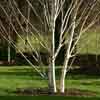|
|
Silver Birch are one of the loveliest small trees giving winter interest with their fabled white bark, but are you aware of just how many other bark colours there are to brighten up your winter garden? The response to these last year was such that we have dramatically increased both the range and numbers for this year. I hope that we will be able to fulfil more of your requirements as a result. There are as many as 60 species of birch, distributed across the northern temperate zone. They develop into extraordinarily elegant trees and are well known for their wonderful bark. However, their yellow autumn colours are a delightful feature too, as are the catkins in the spring. Borne on the same tree, male catkins are long and pendulous whilst the females are shorter and erect. Birch are very tolerant trees and will grow in most soils - they thrive here on our horrible heavy clay. However, they do not care to be moved, so these pot grown examples will minimise root disturbance. We also have a limited number of older and larger specimens for more rapid gratification. These will be carefully lifted and root-balled specially for you so will not suffer at all in the process. Our display plants are now old enough to starting to look magnificent. When the low winter slow catches them in its spotlight, the effect is truly incredible; the combination of the reflected sunlight from the glistening bark complimented by the warm glow as it shines through the curls of peeling bark which is usually a darker colour. If you are in doubt as to exactly which of the many cultivars would best suit your requirements, why not email me to come and see our collection to help you make your choice. The starting size are for plants in 5 litre pots. Of course the exact sizes will vary between cultivars according to their relative vigour, but I would expect most to be around the 6' mark, give or take. (I suppose I should give that as approaching 2m to be politically correct!) We do not clean off side branches, so many are feathered. In addition, there are some older and larger, but more importantly more substantial, plants growing on in the open ground. These will be more expensive of course because they are older. It is most useful if you can give me an idea of what sort of shape and size you would like when you enquire. There are different ways of achieving a multi-stemmed birch. One option is to prune it back hard when young to 3 or 4 buds. This looks dire initially but often results in 3 or 4 strong shoots. This seems ideal, except that these shoots are structurally side-shoots and grow up strongly as competing leaders. The strength of the fork can be inadequate for the resultant leverage, so it is not uncommon for these to then fall to pieces in adverse weather. Arguably the "ultimate" solution is to plant 3 trees in the same hole to achieve the effect of multi-stemmed from the ground. This is the perfect solution - other than for the fact that it is the most expensive (though not so when compared with 1 larger plant equal in stature to the sum of the 3 younger ones). Finally, we never clean the side-growth off our young birch. Thus they become feathered and it is usually possible to choose a plant with the maximum amount of side growth. If this is allowed to develop, then these will become significant branches (without the structural issues of the first solution) giving a multi-stemmed effect. We have planted many like this, and I subsequently remove the twiggier side growth off this main framework to expose the structure in al its glory. Feel
free to discuss your specific requirement with me because we can usually
match the desired shape. |
